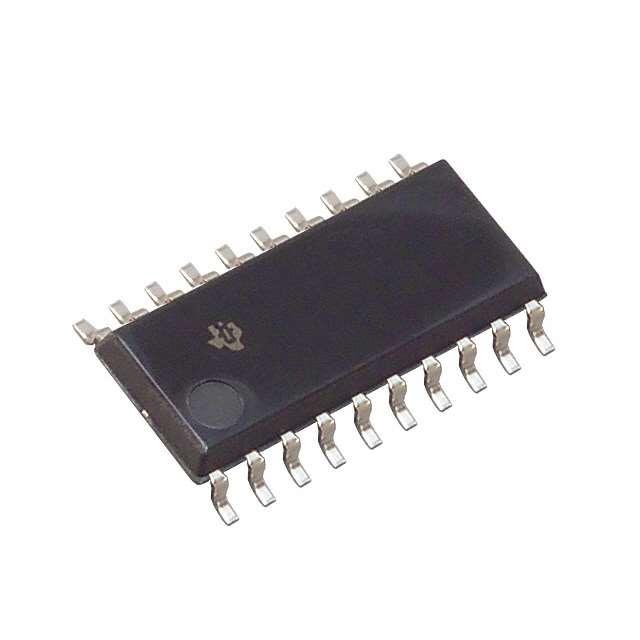SN74ABTR2245NSRE4
Product Overview
Category
SN74ABTR2245NSRE4 belongs to the category of integrated circuits (ICs).
Use
This IC is commonly used for voltage level translation and signal buffering in various electronic devices.
Characteristics
- Voltage level translation: SN74ABTR2245NSRE4 can translate signals between different voltage levels, making it suitable for interfacing between devices operating at different voltage levels.
- Signal buffering: It provides buffering capabilities to ensure proper signal integrity and prevent signal degradation during transmission.
Package
SN74ABTR2245NSRE4 is available in a small-outline integrated circuit (SOIC) package.
Essence
The essence of SN74ABTR2245NSRE4 lies in its ability to facilitate seamless communication between devices operating at different voltage levels by translating and buffering signals.
Packaging/Quantity
SN74ABTR2245NSRE4 is typically packaged in reels or tubes, with a quantity of 2500 units per reel/tube.
Specifications
- Supply voltage range: 2 V to 6 V
- Input voltage range: 0 V to VCC
- Output voltage range: 0 V to VCC
- Operating temperature range: -40°C to +85°C
- Number of channels: 8
- Maximum propagation delay: 10 ns
Detailed Pin Configuration
- A1 - Channel 1 input/output
- B1 - Channel 1 input/output
- GND - Ground
- A2 - Channel 2 input/output
- B2 - Channel 2 input/output
- OE - Output enable
- VCC - Power supply
- B3 - Channel 3 input/output
- A3 - Channel 3 input/output
- B4 - Channel 4 input/output
- A4 - Channel 4 input/output
- B5 - Channel 5 input/output
- A5 - Channel 5 input/output
- B6 - Channel 6 input/output
- A6 - Channel 6 input/output
- B7 - Channel 7 input/output
- A7 - Channel 7 input/output
- B8 - Channel 8 input/output
- A8 - Channel 8 input/output
- VCC - Power supply
Functional Features
- Bidirectional voltage level translation: SN74ABTR2245NSRE4 can translate signals bidirectionally between two voltage domains.
- Output enable control: The OE pin allows the user to enable or disable the output buffers, providing flexibility in signal routing.
- High-speed operation: With a maximum propagation delay of 10 ns, this IC ensures efficient signal transmission.
Advantages and Disadvantages
Advantages
- Wide supply voltage range allows compatibility with various systems.
- Bidirectional voltage level translation simplifies interfacing between devices operating at different voltage levels.
- Output enable control enhances flexibility in signal routing.
Disadvantages
- Limited number of channels (8) may not be sufficient for complex systems requiring a higher channel count.
- Maximum propagation delay of 10 ns may introduce timing constraints in high-speed applications.
Working Principles
SN74ABTR2245NSRE4 operates based on the principles of voltage level translation and signal buffering. It utilizes internal circuitry to detect and convert signals from one voltage domain to another, ensuring seamless communication between devices with different voltage requirements. The output buffers provide impedance matching and signal amplification to maintain signal integrity during transmission.
Detailed Application Field Plans
SN74ABTR2245NSRE4 finds applications in various electronic systems, including but not limited to: 1. Microcontrollers and microprocessors 2. Communication systems 3. Industrial automation 4. Automotive electronics 5. Consumer electronics
In microcontroller and microprocessor-based systems, this IC facilitates communication between different voltage domains, enabling seamless integration of peripherals operating at different voltage levels.
Communication systems benefit from SN74ABTR2245NSRE4's voltage level translation capabilities, allowing interfacing between devices with varying voltage requirements, such as UART, I2C, and SPI interfaces.
Industrial automation relies on this IC for signal buffering and voltage level translation in control systems, ensuring reliable communication between sensors, actuators, and controllers.
Automotive electronics utilize SN74ABTR2245NSRE4 to interface between various subsystems operating at different voltage levels, enhancing overall system performance and reliability.
Consumer electronics, including smartphones, tablets, and gaming consoles, employ this IC to enable communication between different components operating at different voltage levels, ensuring seamless functionality.
Detailed and Complete Alternative Models
- SN74LVC4245APWR: This IC offers similar voltage level translation and signal buffering capabilities but operates at a lower supply voltage range (1.65 V to 5
قم بإدراج 10 أسئلة وإجابات شائعة تتعلق بتطبيق SN74ABTR2245NSRE4 في الحلول التقنية
Sure! Here are 10 common questions and answers related to the application of SN74ABTR2245NSRE4 in technical solutions:
Q: What is SN74ABTR2245NSRE4? A: SN74ABTR2245NSRE4 is a type of integrated circuit (IC) known as a bi-directional transceiver. It allows bidirectional voltage level translation between different logic levels.
Q: What is the voltage range supported by SN74ABTR2245NSRE4? A: SN74ABTR2245NSRE4 supports voltage translation between 1.2V and 3.6V.
Q: How many channels does SN74ABTR2245NSRE4 have? A: SN74ABTR2245NSRE4 has 8 channels, allowing for simultaneous bidirectional translation on multiple data lines.
Q: Can SN74ABTR2245NSRE4 be used for level shifting between different logic families? A: Yes, SN74ABTR2245NSRE4 can be used for level shifting between various logic families such as TTL, CMOS, and LVTTL.
Q: What is the maximum data rate supported by SN74ABTR2245NSRE4? A: SN74ABTR2245NSRE4 supports data rates up to 100 Mbps.
Q: Does SN74ABTR2245NSRE4 have any built-in ESD protection? A: Yes, SN74ABTR2245NSRE4 has built-in ESD protection, which helps safeguard against electrostatic discharge events.
Q: Can SN74ABTR2245NSRE4 be used in both digital and analog applications? A: No, SN74ABTR2245NSRE4 is primarily designed for digital applications and may not be suitable for analog signal translation.
Q: What is the power supply voltage required for SN74ABTR2245NSRE4? A: SN74ABTR2245NSRE4 requires a power supply voltage between 1.65V and 3.6V.
Q: Can SN74ABTR2245NSRE4 handle high-speed data transmission? A: Yes, SN74ABTR2245NSRE4 is capable of handling high-speed data transmission up to 100 Mbps.
Q: Are there any specific layout considerations when using SN74ABTR2245NSRE4? A: Yes, it is recommended to follow the layout guidelines provided in the datasheet to ensure proper performance and minimize noise coupling.
Please note that these answers are general and may vary depending on the specific application and requirements. Always refer to the datasheet and consult with technical experts for accurate information.


